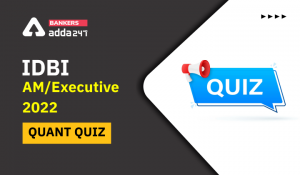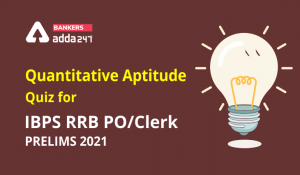Dear Aspirants,
|
Quantitative Aptitude for IBPS Clerk Mains 2017
|
Quantitative Aptitude Section has always given heebie-jeebies to the aspirants whenever they appeared for a banking examination. As the level of every other section is has only got complex and convoluted, there is no doubt that this section, too, makes your blood run cold. The questions asked in this section are calculative and very time-consuming. But once dealt with proper strategy, speed and accuracy, this section can get you the maximum marks in the examination. Following is the quiz on Quantitative Aptitude to help you practice with the best of latest pattern questions.
Q1. The sum of money is to be divided amongst A, B and C in the respective ratio of 3 : 4 : 5 and another sum of money to be divided between E and F equally. If F got Rs. 1050 less than A, how much amount did B receive?
(a) Rs. 750
(b) Rs. 2000
(c) Rs. 1500
(d) Cannot be determined
(e) None of these
Q2. Three friends Anita, Bindu and Champa divided Rs. 1105 among themselves in such a way that if Rs. 10, Rs. 20 and Rs. 15 are removed from the sum that Anita, Bindu and Champa received respectively, the share of the sum that they got will be in the ratio of 11 : 18 : 24. How much did Champa received?
(a) Rs. 495
(b) Rs. 510
(c) Rs. 480
(d) Rs. 375
(e) Rs. 445
Q3. On his deathbed, Mr. Kalu called upon his three sons and told them to distribute all his assets worth Rs. 525,000 in the ratio of 1/15 ∶1/21 ∶1/35 amongst themselves. Find the biggest share amongst the three portions.
(a) Rs. 17,5000
(b) Rs. 24,5000
(c) Rs. 10,5000
(d) Rs. 13,2500
(e) Rs. 12,3500
Q4. King Sheru has ordered the distribution of apples according to the following plan : for every 20 apples the elephant gets, the zebra should get 13 apples and the deer should get 8 apples. Now his servant Shambha jackal is in a fix. Can you help him by telling how much should he give to the elephant if there were 820 apples in total?
(a) 140
(b) 160
(c) 200
(d) 400
(e) 450
Q5. Two horses started simultaneously towards each other and meet each other 3 hr 20 min later. The ratio of speed of faster horse to that of slower horse is 3 : 1.How much time will it take the slower horse to cover the whole distance if the slower arrived at the place of departure of the faster 5 hours later than the faster arrived at the point of departure of the slower after they meet?
(a) 10 hours
(b) 40/3 hours
(c) 44/3 hours
(d) 16 hours
(e) 46/3 hours
Q6. A man has Rs. 9000, some of which he deposits in Bank A at 6% S.I. and remaining he deposits in Bank B at 8% S.I.. If the total interest he earns is Rs. 1800 in three years. What is the amount invested at 6%?
(a) Rs. 3000
(b) Rs. 6000
(c) Rs. 4000
(d) Rs. 4500
(e) Rs. 5400
Q7. An amount of money is to be divided among P, Q and R in the ratio 4 : 9 : 16. If R gets 4 times more than P, what is Q’s share in it?
(a) Rs. 1800
(b) Rs. 2700
(c) Rs. 3600
(d) Data inadequate
(e) None of these
Q8. A sum of Rs. 1440 is lent out in three parts in such a way that the interest on first part at 2% for 3 years, second part at 3% for 4 years and third part at 4% for 5 years are equal. Then the difference between the largest and the smallest sum is
(a) Rs. 400
(b) Rs. 560
(c) Rs. 460
(d) Rs. 200
(e) Rs. 250
Q9. If a sum of money at compound interest doubles itself in 15 years, it will become eight times of itself in
(a) 60 years
(b) 48 years
(c) 54 years
(d) 45 years
(e) 30 years
Q10. On selling a Pen at 5% loss and a book at 15% gain, Karim gains Rs. 7. If he sells the Pen at 5% gain and the book at 10% gain, then he gains Rs. 13. The actual price of the book is
(a) Rs. 100
(b) Rs. 80
(c) Rs. 10
(d) Rs. 400
(e) Rs. 180
Q11. The cost price of three varieties of apples namely A, B and C is Rs. 20/kg, Rs. 40/kg and Rs. 50/kg respectively. Find the selling price of one kg of apple in which these three varieties of apple are mixed in the ratio of 2 : 3 : 5 such that there is a net profit of 20%?
(a) Rs. 48
(b) Rs. 48.6
(c) Rs. 49.2
(d) Rs. 49.8
(e) Rs. 42.9
Q12. A person bought two tables for Rs. 2200. He sells one at 5% loss and the other at 6% profit and thus on the whole he neither gains nor loses. Find the cost price of each table.
(a) Rs. 1500, Rs. 700
(b) Rs. 2000, Rs. 200
(c) Rs. 1200, Rs. 1000
(d) Rs. 1100, Rs. 1100
(e) Rs. 1050, Rs. 1150
Q13. A sells goods to B at five-thirds to that rate of profit at which B has decided to sell it to C. C, on the other hand, sells it to D at one-third the rate of profit at which B sold it to C. If D gives Rs. 2145 to C at 10% profit, how much did A buy it for?
(a) Rs. 1000
(b) Rs. 2000
(c) Rs. 1500
(d) Rs. 1800
(e) Rs. 1600
Q14. Uday wants to sell 40 chairs. If he sells them at Rs. 156 per chair, he would be able to sell all the chairs. But for every Rs. 6 increment in price, he will be left with one additional unsold chair. At what selling price would he be able to maximize his profits (assuming unsold chairs remain with him)?
(a) Rs. 198
(b) Rs. 192
(c) Rs. 204
(d) Rs. 210
(e) Rs. 120
Q15. A merchant makes a profit of 20% by selling an article. What would the percentage change have been in the profit percentage had he paid 10% less for it and the customer paid 10% more for it with respect to previous selling price?
(a) 120%
(b) 125%
(c) 133.33%
(d) 150%
(e) 11.111%
You may also like to Read:
- Quantitative Questions for upcoming Banking and Insurance Examinations
- Study Notes of Quantitative Aptitude
- Practice More Data Interpretation Questions
- Quantitative Aptitude Section Strategy





 Quantitative Aptitude Quiz For IDBI AM/E...
Quantitative Aptitude Quiz For IDBI AM/E...
 Quantitative Aptitude Quiz For IBPS RRB ...
Quantitative Aptitude Quiz For IBPS RRB ...





